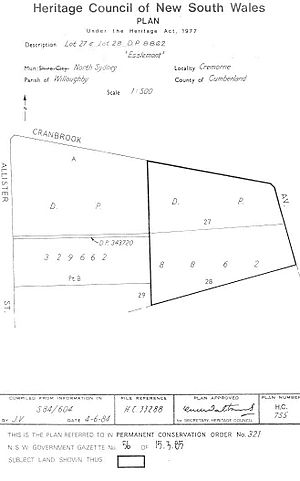Egglemont facts for kids
Egglemont is a special old house located at 11 Cranbrook Avenue in Cremorne, New South Wales, Australia. It was built between 1916 and 1918. This house is also known as Esslemont. It's considered very important for its history and design, so it was added to the New South Wales State Heritage Register on April 2, 1999.
Quick facts for kids Egglemont |
|
|---|---|

Heritage boundaries
|
|
| Location | 11 Cranbrook Avenue, Cremorne, North Sydney Council, New South Wales, Australia |
| Built | 1916–1918 |
| Architectural style(s) | Californian Bungalow |
| Official name: Egglemont; Esslemont | |
| Type | State heritage (built) |
| Designated | 2 April 1999 |
| Reference no. | 321 |
| Type | House |
| Category | Residential buildings (private) |
| Lua error in Module:Location_map at line 420: attempt to index field 'wikibase' (a nil value). | |
Contents
History of Egglemont
Egglemont was built around 1916 to 1918. It was designed in the Californian Bungalow style, which was very popular at that time. The house has four bedrooms and features a garden that was typical for homes built in this period.
What Does Egglemont Look Like?
The Site and Garden
Egglemont is located on a sloping piece of land on Cranbrook Avenue. It fits in well with other houses nearby, especially one designed by Alexander Stuart Jolly. The area around the house has changed over the years, with some modern apartment buildings built in the 1970s.
The house has a low, stepped wall at the front, made of plastered stone. There are stone walls on either side of a wide timber gate. This gate leads to a path made of "crazy-paved" sandstone, which means the stones are laid in an irregular pattern. This path goes right to the front door. Large shrubs help screen the house from the street. The name "Esslemont" is carved into the stone wall near the main gate.
There's another gate on the uphill side of the house, made of Art Deco iron. Next to it is a paved tennis court with a tall fence. Behind the tennis court, there's a grassy area and a small garage. The property also has a swimming pool. At the back of the house, there's a small flat lawn with shrubs. The garden style is typical of the time the house was built.
The House Itself
The house was built around 1916-1918 and is considered one of the best examples of an early Californian Bungalow in Australia. The way it's built, the materials used, and the detailed work show the quality of this style.
It's a large, single-story house with a low, wide roof and gables (the triangular parts of a wall under a sloping roof). These are supported by heavy timber beams. The house also has small leadlight windows and strong, round verandah piers (columns).
Inside, Egglemont is quite spacious. It includes a billiard room, a large sunroom, and a dressing room with an ensuite bathroom for the main bedroom. There's also a kitchen, laundry, and a scullery, which was a small room used for washing dishes and other kitchen tasks, often by domestic staff. The house has not changed much in the last 60 years. One small change was extending one of the bedrooms into a northern verandah. The kitchen cupboards were also updated in the 1960s. The laundry still has some original features like china double tubs and pedestals.
The house has four bedrooms and sits on a property of about 1640 square meters.
Changes Over Time
- Around 2006, a type of cypress hedge was planted along the boundary facing a block of flats next door.
- In 2011, there was a legal discussion about this hedge with the neighbors from the flats. The application was later withdrawn after talks.
Why Egglemont is Heritage Listed
Egglemont was officially listed on the New South Wales State Heritage Register on April 2, 1999. This means it is recognized as an important historical place that should be protected for future generations to enjoy and learn from.

